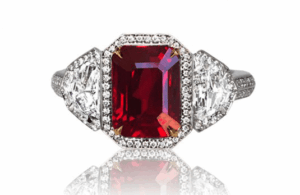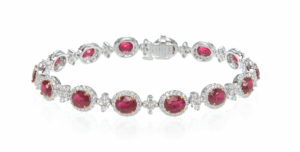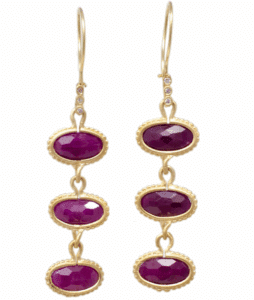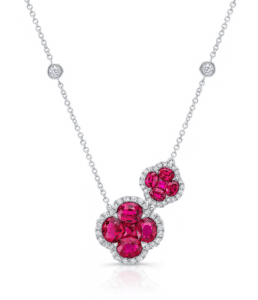By Andrea Venn, Ph.D., CGA, JEA
If you’re looking to enhance your jewelry collection with one of the original precious gems, ruby may be the perfect fit for you. Ruby is the red form of corundum. Corundum can be seen in multiple hues due to trace elements. The trace element chromium gives corundum its red color, and it can also cause fluorescence, which further enhances the red hue. This separates ruby from all other colors of corundum, which are instead referred to as sapphire. The American Gem Society specifies that ruby must be a medium or darker tone of red, while corundum displaying a lighter than medium red tone must be referred to as pink sapphire.
This vivid red gem is the birthstone for July, as well as the gemstone for the 15th, 40th, and 80th anniversaries, the last of which is referred to as the Ruby Jubilee. Rubies register 9.0 on the Mohs hardness scale, which makes them resistant to scratches and ideal for everyday wear.
Due to their rich red hue, sparkle, and hardness, rubies have remained popular in classic earrings, necklaces, rings, and bracelets, as well as cutting-edge, creative designs. Rubies frequently appear in men’s jewelry, worn in earring studs, pinky rings, brooches, and cufflinks, and both men and women embrace ruby retro and antique jewelry.
Rubies were mined in Sri Lanka as rathu kata over 2,500 years ago, and they made their way to the west in jewelry with the Etruscans around the 6th century BCE. Ruby is referred to in Sanskrit as ratnaraj, which means “King of Gems,” and its current name is likely derived from the Latin adjectives for red, rufus or ruber.
For people who love symbolism, rubies have been used in literature as symbols of passion, vitality, strength, beauty, and fire, and can be seen in works by famed authors such as Pliny, Chaucer, and Shakespeare. Rubies are mentioned several times in the Bible as comparisons of value and great worth: “For wisdom is better than rubies; and all the things that may be desired are not to be compared to it” (Proverbs 8:11).
This gemstone’s popularity continued into the Renaissance, where rubies were embraced as symbols of wealth and power for nobility and royalty. Queen Elizabeth I’s courtiers presented her with luxurious gifts, including rubies in headpieces, jewelry, and fans. Many of the “rubies” admired at the time were actually spinel. Found in the same deposits and visually similar, the two weren’t distinguished until 1783. As a result, the Black Prince’s Ruby and the Timur Ruby in the British royal collection were later identified as spinel.
When purchasing rubies or ruby jewelry, be sure to ask if they have been treated and if so, how. All treatments must be disclosed, as they can have a significant effect on value. Heated, treated rubies should sell for a fraction of the cost of untreated natural rubies of quality. Avoid relying on trade names like “Burma Ruby” or “Siam Ruby” that may or may not be indicative of the gemstone’s origin. Also, be aware that synthetic rubies and ruby simulants are frequently sold as less expensive alternatives in items such as birthstone jewelry and class rings.
Rubies have been cherished for centuries—and their timeless appeal isn’t fading anytime soon. Why not add this vibrant gemstone to your collection? Search for an American Gem Society jeweler near you at ags.org/findajeweler.
References:
- Joan Evans, A History of Jewellery 1100-1870 (Dover Publications, New York, 1989).
- Gemological Institute of America, “Ruby,” Gem Identification Lab Manual (2005).
- Gemological Institute of America, “Ruby,” GIA.edu. Accessed July 21, 2025. https://www.gia.edu/ruby-description
- Walter Schumann, Gemstones of the World, 5th ed. (Sterling, New York, 2013).
- Gerald D. Sisk Jr., Guide to Gems and Jewelry (Jewelry Television, 2011).
- Jerry Sisk, The Sisk Gemology Reference, Vol. 1: Prominent Gems (Jewelry Television, 2016).



